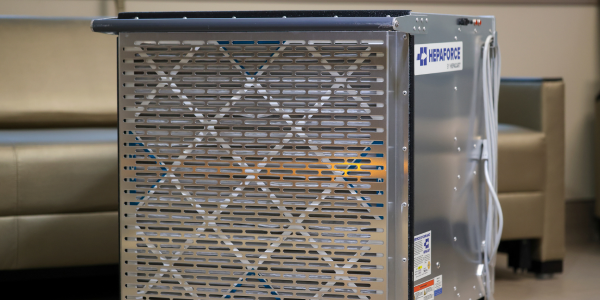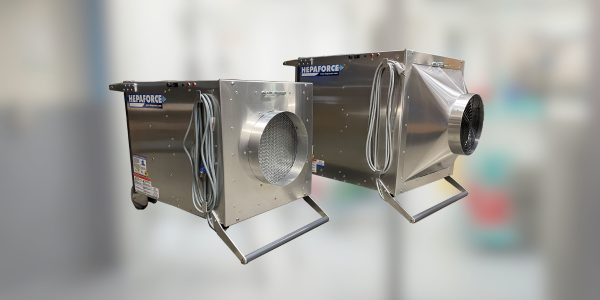Share this
Clear the Air: How Portable Air Scrubbers Tackle Dust Head-on
by HEPACART on Jan 20, 2025

As a healthcare facility manager, you're no stranger to the challenges of maintaining clean, safe environments. Your priority is clear: protecting the health of patients, staff, and visitors while staying compliant with strict air quality standards. But in settings with constant activity, construction, or renovation, controlling indoor air quality (IAQ) can feel like an uphill battle.
Air contamination from dust, mold, cleaning agents, and pathogens is an ever-present risk. Left unchecked, these contaminants can lead to serious health issues, including hospital-acquired infections (HAIs). Portable HEPA air scrubbers provide a practical, efficient solution to keep your facility safe and compliant. These devices are more than just air purifiers — they’re essential tools in ensuring healthier indoor air for everyone who walks through your doors.
Indoor Air Pollutants are Everywhere — Are You Prepared?
Air contamination is an unavoidable challenge in any healthcare facility. Pollutants of any kind can not only impact the ability of your patients to be comfortable and heal but can also lead to dangerous hospital-acquired infections (HAIs) and further complicate patient recovery.
Common Sources of Indoor Air Pollution Include:
- Cleaning Agents: The spectrum of chemicals used in heavy-duty cleaning varies widely, but many of them can irritate patients in a medical setting.
- Paints: Introduce potentially harmful chemicals into the indoor air — particularly when fresh paint is applied.
- Pesticides: Toxic chemicals intended to prevent insect infestations can also cause harm to sensitive hospital patients.
- Aging Building Materials: Older buildings may release pollutants like asbestos into the air as the materials break down over time.
- New Building Materials: Products like pressed lumber can release toxic off-gassing into the surrounding environment.
As a facility manager, understanding these sources is the first step in combating air contamination. Portable air scrubbers, especially those equipped with HEPA filters, are designed to address these challenges head-on by capturing airborne contaminants and improving IAQ throughout your facility.
3 Practical Strategies to Minimize Construction Dust in Medical Settings
It’s not enough to simply understand the sources of dust and pollutants. Your IAQ depends on your facility’s ability to improve the air quality by removing or redirecting harmful airborne particles. This can be done with cleaning and maintenance, ventilation, and purification and filtration equipment.
- Regular Cleaning and Maintenance: Proactive and routine care of HVAC systems, air ducts, and structural components of the facility is a great first step. Diligent maintenance curbs the buildup of dust, mold, and various other pollutants and makes the work of your filtration systems more efficient.
- Ensuring Proper Ventilation: Facility managers are tasked with ensuring that the building’s ventilation systems are not just operational, but also efficient in circulating fresh air throughout the facility. This can mean both ensuring that HVAC systems are functioning properly but also that your teams are making the best use of open windows and other methods of ventilation around the building.
- Implementing Air Purifiers, Filters, and Scrubbers: Making use of air purifiers and filters in strategic locations, especially in high-traffic zones, can dramatically enhance air quality. Whether you opt for a high-efficiency particle air, HEPA, filtration system, air scrubber, or purification system, these tools are excellent ways to support a healthy IAQ for a modern medical center.
Air Scrubbers: The Ultimate Weapon Against Indoor Pollution
Portable air scrubbers are versatile pieces of filtration that continuously clean the air in your facility. They work by pulling in contaminated air, filtering it through advanced systems, and releasing clean air back into the environment. The HEPA filters used in these machines are rigorously tested to ensure they are highly effective, capturing 99.97% of particles as small as 0.3 microns. This includes common healthcare pollutants such as dust, bacteria, mold spores, and even viruses.
For example, during construction or renovation projects, a portable air scrubber can mitigate the spread of dust and debris, protecting sensitive areas like patient wards or operating rooms. These devices are also invaluable in isolation zones, where maintaining clean air is critical to preventing the spread of pathogens.
By continuously filtering airborne contaminants, portable air scrubbers ensure that your facility remains a safe space for everyone — patients, visitors, and staff alike.
Why HEPA Filtration Is a Must-Have
Not all filtration systems are created equal. HEPA (High-Efficiency Particulate Air) filters set the gold standard for air purification, especially in healthcare environments. Unlike standard filters, HEPA filters trap nearly all airborne particles, including the microscopic ones that pose the greatest risks in medical settings.
The difference is clear when comparing HEPA air scrubbers to conventional air purifiers. While standard air purifiers may reduce the overall pollutant load, they often fail to capture smaller, more harmful particles. HEPA air scrubbers, on the other hand, are specifically designed to meet the high standards of healthcare facilities, ensuring both safety and compliance.
The benefits of HEPA filtration are especially evident during construction. Renovation work releases large amounts of fine dust and debris that can easily spread through a facility. Portable air scrubbers equipped with HEPA filters are essential in containing these particles and minimizing their impact.
Negative Air Machines & Scrubbers: The Dust Control Dream Team

For enhanced air quality control, portable air scrubbers can be paired with negative air machines. Negative air machines create pressure-controlled environments that isolate contaminants within a specific space. This combination is particularly effective in construction zones, isolation wards, and other areas requiring strict contamination control.
Here’s how it works: the negative air machine maintains the desired air pressure to keep contaminants from spreading, while the air scrubber continuously filters the air, removing pollutants and ensuring a clean environment. Together, these devices provide unparalleled control over IAQ, making them a powerful solution for any healthcare facility.
Going Beyond Air Purification With Air Scrubbers

Portable air scrubbers aren’t limited to cleaning the air. Advanced models can also indirectly clean surfaces by releasing charged particles that neutralize pathogens. This dual action adds another layer of protection that is incredibly valuable when the health and safety of patients, staff, and visitors are on the line.
Air scrubbers are widely used to clean the air in medical facilities, factories, classrooms, commercial buildings, job sites, and any other places where there is a risk or concern of airborne pollutants — ranging from dust and mold spores to viruses and bacteria.
Maintain Your Air Scrubber for Ongoing Peak Performance
To get the most out of your portable air scrubber, regular maintenance is essential. HEPA filters should be replaced according to the manufacturer’s guidelines to ensure they’re effectively capturing contaminants. Cleaning the machine’s exterior and intake areas can also prevent dust buildup that might impact performance.
Periodic testing of the HEPA filters ensures the system continues to operate at peak efficiency. For facilities with high pollutant loads, particle count tests can verify that the air scrubber is meeting IAQ standards.
Proper maintenance not only extends the life of your equipment but also ensures consistent protection against airborne contaminants, giving you peace of mind in your IAQ strategy.
Selecting the Perfect Air Filtration System for Your Healthcare Facility
Selecting the right portable air scrubber depends on your facility’s unique needs. Start by evaluating the size of the areas where the scrubber will be used. Larger spaces may require units with higher airflow rates or multiple machines to ensure proper coverage.
Consider the types of pollutants present. For example, if your facility faces significant chemical off-gassing, a scrubber with an activated carbon filter may be beneficial. If surface cleaning is also a priority, look for models with advanced ionization technology.
HEPA compliance is a non-negotiable feature for healthcare environments. Ensuring your equipment meets these standards guarantees the highest level of air filtration, keeping your facility compliant and safe.
Support a Healthier Future With Portable HEPA Air Scrubbers
Indoor air quality is more than just a compliance issue — it’s a cornerstone of patient care and staff well-being. Portable HEPA air scrubbers provide a reliable, efficient solution to combat air contamination in healthcare settings, ensuring safer environments for all.
By investing in high-quality air scrubbers, you’re taking a proactive step toward better air quality, healthier outcomes, and greater compliance. Don’t let air contamination compromise your facility. Embrace the power of portable air scrubbers today.

